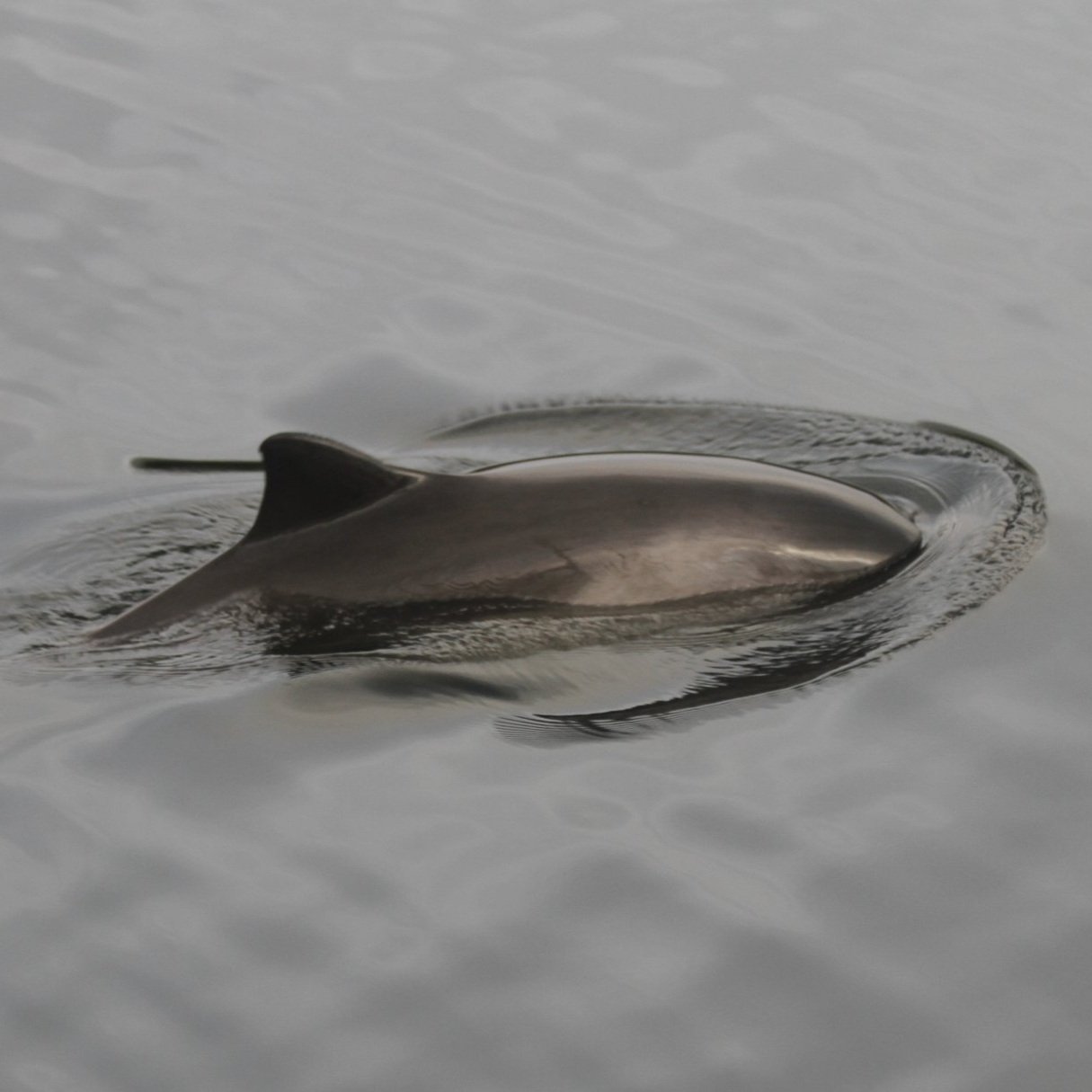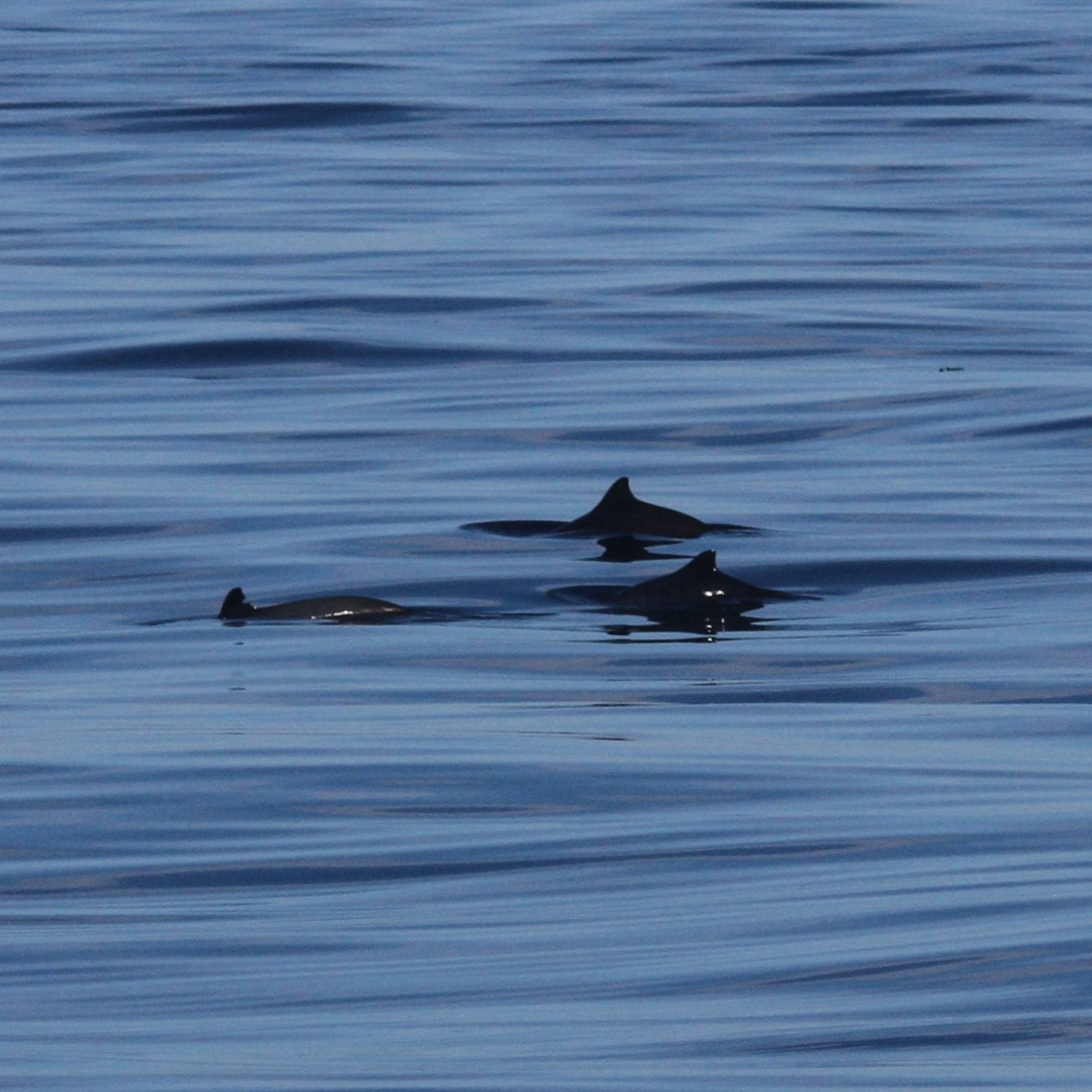Harbour porpoises respond to chronic and repeated seal scarer noise from aquaculture
Data gathered during research expeditions on our research vessel, Silurian, has shown that harbour porpoise are negatively impacted by Acoustic Deterrent Devices, which are used to deter seals at aquaculture sites. Here, Dr Charlotte Findlay, details the research she led to better understand the impact on this species.
Harbour porpoises are the smallest cetacean (i.e., whales, dolphins, and porpoises) found in UK waters and they occur in very high densities all year round on the west coast of Scotland [1]. However, harbour porpoises are believed to be one of the most sensitive species of marine mammal when it comes to being disturbed by human-made underwater noises, with numerous scientific studies reporting responses to noise from boats, pile-driving for offshore windfarms, pingers and Acoustic Deterrent Devices (ADDs; also called Acoustic Harassment Devices or Seal Scarers).
On the west coast of Scotland, aquaculture is an important rural industry. But it experiences depredation events by harbour seals and grey seals which can be economically expensive. To try and reduce seal attacks on caged fish, and as an alternative to the shooting of seals at aquaculture sites (which was banned in Scotland in 2020), ADDs had previously been recommended as a method of mitigation. To reduce impacts from seals, multiple ADDs are often deployed on aquaculture cages and continuously produce loud (>185 dB re 1 µPa RMS), mid- to high-frequency sounds underwater (0.5 to 40 kHz). However, the effectiveness of ADDs at deterring seals has not yet been proven, and the sound from these devices can result in large coastal areas used by marine mammals being exposed to this noise [2],[3].
Harbour porpoises have previously been found to respond to ADD noise when used for short periods at distances up to 12 km, suggesting that individuals could be altering their echolocation behaviour which indicates they stopped foraging, or become displaced from biologically important habitats used for foraging, resting, and reproducing. However, we do not know if harbour porpoises on the west coast of Scotland, which have been exposed to repeated and chronic ADD noise from aquaculture over many years, will continue to respond to the noise from these devices or if they have gotten used to this sound over time.
To answer this question, we used 9-years (2011-2019) of acoustic line-transect data for harbour porpoises and ADD presence collected across the entire west coast of Scotland by HWDT. ADD perceived loudness was based on a scale of 0 (no ADD) to 5 (the loudest an ADD could be) as defined by volunteers on RV Silurian during listening stations.
Silurian, HWDTs research vessel, with an aquaculture site in the background
Our study found that harbour porpoises on this coastline responded to repeated and chronic ADD noise from aquaculture, which indicated that individuals had changed their echolocation behaviour or were displaced from important habitats, which may have had fitness consequences for this species and the larger population in this region. The most intense ADD noise defined by volunteers (category 5) coincided with significantly fewer harbour porpoise detections when compared to areas with no ADD noise (category 0). This was equivalent to an estimated displacement of 34% of the total undisturbed population assuming they left the area and did not remain and just stop echolocating. Responses by harbour porpoises were also estimated to begin occurring when ADD underwater noise levels were more than 108 dB re 1 µPa RMS (weighted for the hearing of harbour porpoises).
Concern for cetaceans exposed to ADD noise resulted in licenses being required to use these devices in Scotland in 2021 [4], which has led to an overall reduction in their use based on more recent data collected during HWDT expeditions [5]. However, ADDs are used globally by aquaculture and static fisheries. It is therefore recommended that the aquaculture industry moves away from ADDs and continues to develop and improve on non-acoustic and non-lethal methods to reduce pinniped (i.e., seals, sea lions and fur seals) depredation. This could be through improving animal husbandry, reducing fish stock densities, seal blinds, anti-predator nets, maintaining correct net tensioning, and using stronger and stiffer net materials (e.g., high density polyethylene netting) [6]. This shift will help to reduce the overall noise levels in coastal areas where aquaculture production occurs and help decouple the aquaculture industry from harmful effects on cetaceans.
As authors we want to say a huge thank you to the staff members and volunteers who collected data on cetaceans and ADDs with HWDT between 2011 and 2019. We also want to thank HWDT members, donors and funders over the past 20 years including: Heritage Lottery Fund, The Nàdair Trust, NatureScot (formally Scottish Natural Heritage), WWF-UK, Coastal Communities Fund, William Grant Foundation, Sea-Changers and the True and Fair Foundation. This study was also funded by European Social Fund and Scottish Funding Council as part of Developing Scotland's Workforce in the Scotland 2014–2020 European Structural and Investment Fund (ESIF) Programme, and the European Union's Horizon Europe Framework Programme under the Marie Skłodowska-Curie Actions grant agreement No. 101063364.
To read more about this study you can follow this link:
https://www.sciencedirect.com/science/article/pii/S0006320724001319#bb0190
Anyone can join a research expedition. This vital data collection programme is made possible by you participating - over 2 decades more than 1,000 people have joined, gathering a colossal amount of data, used to better understand and protect these awesome creatures in our waters.
[1] https://hwdt.org/hebridean-marine-mammal-atlas
[2] Findlay, C.R., Aleynik, D., Farcas, A., Merchant, N.D., Risch, D., Wilson, B., 2021. Auditory impairment from acoustic seal deterrents predicted for harbour porpoises in a marine protected area. Journal of Applied Ecology. 58, 1631–1642. https://doi.org/10.1111/ 1365-2664.13910.
[3] Findlay, C.R., Hastie, G.D., Farcas, A., Merchant, N.D., Risch, D., Wilson, B., 2022. Exposure of individual harbour seals (Phoca vitulina) and waters surrounding protected habitats to acoustic deterrent noise from aquaculture. Aquatic Conservation: Marine and Freshwater Ecosystems. 32(5), 766-780. https://doi.org/10.1002/aqc.3800.
[4] Marine Scotland, 2021. Information Note and Frequently Asked Questions for the Operators of Finfish Farms on the Use of Acoustic Deterrent Devices and the Requirement for a European Protected Species Licence.
[5] Hampson, J., Findlay, C.R., Ripple, H.D., Risch, D., Lomax, A., Hartny-Mills, L., 2023. Policy change leads to reduction in use of acoustic deterrent devices on the west coast of Scotland. In: 34th European Cetacean Society Conference, p. 1. O’Grove, Spain. https://www.thebdri.com/ecs2023abstractbook.pdf.
[6] Thompson, D., Coram, A.J., Harris, R.N., Sparling, C.E., 2021. Review of non-lethal seal control options to limit seal predation on salmnonids in rivers and at finfish farms. Scottish Marine and Freshwater Science, 12(6), 1-136. https://doi.org/10.7489/12369-1.




